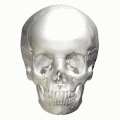| Angle of the mandible | |
|---|---|
 Human skull. Position of angle of the mandible shown in red. | |
 1870s American male skull. The angle of the mandible is visible just above the white number. | |
| Details | |
| Identifiers | |
| Latin | Angulus mandibulae |
| TA98 | A02.1.15.025 |
| TA2 | 861 |
| FMA | 59459 |
| Anatomical terminology | |
The angle of the mandible (gonial angle) is located at the posterior border at the junction of the lower border of the ramus of the mandible.
The angle of the mandible, which may be either inverted or everted, is marked by rough, oblique ridges on each side, for the attachment of the masseter laterally, and the pterygoideus internus (medial pterygoid muscle) medially; the stylomandibular ligament is attached to the angle between these muscles.
The forensic term for the midpoint of the mandibular angle is the gonion. The gonion is a cephalometric landmark located at the lowest, posterior, and lateral point on the angle.[1] This site is at the apex of the maximum curvature of the mandible, where the ascending ramus becomes the body of the mandible.
The mandibular angle has been named as a forensic tool for gender determination, but some studies have called into question whether there is any significant sex difference in humans in the angle.[2][3]
Many mammals have a distinctive bony prong, the angular process, immediately above the angle of the mandible.[4]
See also
Additional images
 Position of angle of the mandible (shown in red). Animation.
Position of angle of the mandible (shown in red). Animation. Mandible bone. Position of angle shown in red.
Mandible bone. Position of angle shown in red. Mandible. Outer surface. Side view. (Angle labeled at bottom right.)
Mandible. Outer surface. Side view. (Angle labeled at bottom right.) Mandible. Inner surface. Side view. (Angle visible at bottom left.)
Mandible. Inner surface. Side view. (Angle visible at bottom left.) The Pterygoidei; the zygomatic arch and a portion of the ramus of the mandible have been removed.
The Pterygoidei; the zygomatic arch and a portion of the ramus of the mandible have been removed. Mandible. Inner surface. Angle of mandible labeled at bottom right.
Mandible. Inner surface. Angle of mandible labeled at bottom right.
References
![]() This article incorporates text in the public domain from page 174 of the 20th edition of Gray's Anatomy (1918)
This article incorporates text in the public domain from page 174 of the 20th edition of Gray's Anatomy (1918)
- ↑ "ANTH 6 Forensic Anthropology Measuring Adult Human Remains". Archived from the original on 2015-08-21. Retrieved 2015-07-10.
- ↑ Upadhyay RB, Upadhyay J, Agrawal P, Rao NN (January 2012). "Analysis of gonial angle in relation to age, gender, and dentition status by radiological and anthropometric methods". J Forensic Dent Sci. 4 (1): 29–33. doi:10.4103/0975-1475.99160. PMC 3470415. PMID 23087579.
- ↑ Gungor K, Sagir M, Ozer I (June 2007). "Evaluation of the gonial angle in the Anatolian populations: from past to present". Coll Antropol. 31 (2): 375–8. PMID 17847912.
- ↑ "Angular process - vet-Anatomy - IMAIOS". www.imaios.com. Retrieved 2023-03-08.
External links
- lesson4 at The Anatomy Lesson by Wesley Norman (Georgetown University)
- Anatomy photo:34:st-0202 at the SUNY Downstate Medical Center - "Oral Cavity: Bones"
- "Anatomy diagram: 34256.000-2". Roche Lexicon - illustrated navigator. Elsevier. Archived from the original on 2013-06-11.
- Anatomy image: skel/mandible2 at Human Anatomy Lecture (Biology 129), Pennsylvania State University